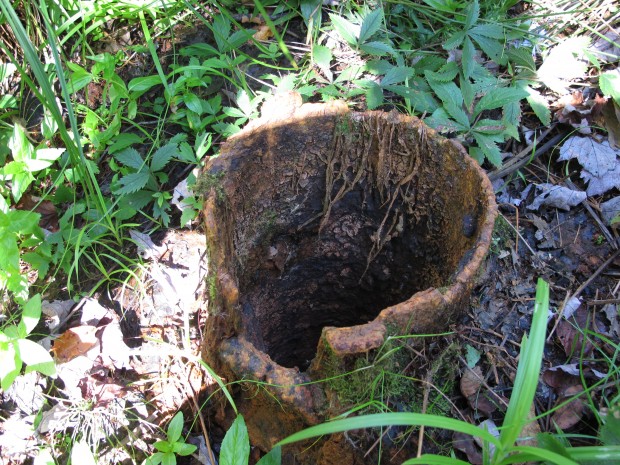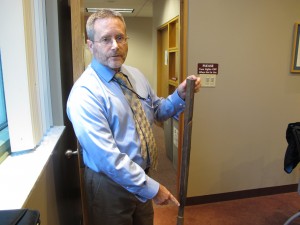
An abandoned, unplugged well near the Allegheny National Forest
Scott Detrow / StateImpact Pennsylvania


An abandoned, unplugged well near the Allegheny National Forest
Scott Detrow / StateImpact Pennsylvania

Scott Detrow / StateImpact Pennsylvania
An abandoned, unplugged well near the Allegheny National Forest

Scott Detrow / StateImpact Pennsylvania
An abandoned, unplugged well near the Allegheny National Forest

Pine runs the DEP’s division in charge of finding abandoned wells and plugging them with cement so that they won’t do harm. Simply by the numbers, it’s an overwhelming job. The best guess of both the state and the energy industry is that somewhere in the neighborhood of 325,000 wells have been drilled in Pennsylvania since Drake’s. Of those, about 120,000 have state permits on file. “Just do the math,” Pine says. “There’s probably close to 200,000 wells that are largely or relatively unaccounted for in the commonwealth.”

Scott Detrow / StateImpact Pennsylvania
Gene Pine, who heads the Department of Environmental Protection's abandoned wells unit, shows off a "sucker rod" found inside a well drilled in the 1870s
The program Pine runs has never been funded at a level anywhere close to the scale of its job of finding and plugging all of those wells.
The effort began with a 1984 law, Pennsylvania’s first to set a standard, sweeping set of oil and gas drilling regulations. That’s when the state required drillers to register their wells, and to plug inactive oil and gas wells with cement. The legislation also included a $50 surcharge assessed to drillers filing for permits. The money — later increased to $150 for oil wells and $250 for gas wells — was used to create the Abandoned and Orphaned Well Program, the division Pine leads now.
The legislation set 1979 as a cutoff date. If a company or landowner owned or made money off a well after that date, they bore responsibility for plugging the wells. Otherwise, the state had the right to step in and close it.
The program started slowly, plugging just seven wells in 1989. It maintained that slow pace for the next decade, plugging more than 20 wells a year only two times, and spending an average of $226,000 a year.
Things changed in 2000, when a state bond issue called “Growing Greener” passed. The bond money, aimed at boosting environmental efforts, added an average of $1.1 million to the program’s annual surcharge revenues over the ensuing decade. With that infusion, the state plugged about as many wells in 2000 as it had in the previous decade.
But the Growing Greener revenue has gradually decreased, and the Orphaned and Abandoned Well Program is back to subsiding on its relatively meager surcharge money. The Marcellus boom means the program receives more permit revenue than it used to, but the pace of plugging has still slowed down. Instead of plugging more than 300 wells, like it did in 2008, the program has closed just 23 wells this year. In all, Pennsylvania’s efforts have plugged 2,871 wells.
The lack of funding forces the Department of Environmental Protection to triage the unit’s work according to which wells pose the greatest danger. “We can’t plug every well. We don’t have the resources to do that, nor do we have the contractors to do that,” Pine says. “If there’s no evidence a well is leaking oil or gas, and it’s not near a home or body of water, then that would be given a lower priority than a well that clearly is leaking into a stream, or is near a backyard.”
Pennsylvania isn’t unique in this respect. Many states have large numbers of abandoned wells with little resources to do anything about them. West Virginia has located about 13,000 abandoned wells, but only plugged 28 in 2010. Ohio’s program plugged 15 last year, and 12 in 2010.
The only legacy drilling state sealing off large swaths of wells is Texas, which plugged more than 800 in 2011. Our partners at StateImpact Texas took a look at well-plugging efforts in the Lone Star State earlier this year.
“The tragedy is that for many years, DEP . . . has felt uncomfortable with the number of undocumented wells out there,” says Jay Parrish, who served as Pennsylvania’s top geologist for a decade. “Every year we come across them and try to document them, but there’s never been any significant money to try and plug them. It’s one of those things that if we had been doing it all along for many years, we would have spread the cost. But it didn’t seem like a high priority for people.”
Pennsylvania is, of course, reaping more than $200 million from the natural gas drilling industry this year. That money comes from a new law, known as Act 13, that charges a $50,000 fee on most Marcellus Shale wells. (Smaller, vertical wells pay a reduced rate.) Well plugging was one of the initial uses Governor Tom Corbett proposed for such a fee — and Act 13 designates it as one of the possible uses for a $16 million pot of revenue. But the money won’t be going to DEP.
That’s because the way the law was written, that $16 million was reserved for local governments, nonprofits, colleges, or environmental groups. The Abandoned and Orphaned Well Program does not qualify.
Despite that, the program is moving forward with efforts to streamline and improve its database of known wells. DEP is collecting maps and other relevant documents from state and county historical organizations. Deputy Secretary Scott Perry sent a letter to oil and gas drillers earlier this year, asking them to forward along any maps or documentation they have about where old wells might lie. (Read the letter at the bottom of this post.)
The goal is to merge this data with modern digital maps, in order to create a more comprehensive record of abandoned wells. A pilot program in southwest Pennsylvania showed encouraging results: “In addition to the wells we know about, we found 15,000 additional new wells,” says Gene Pine. That total — which has since been increased to 17,000 — includes active wells, too, so it doesn’t necessarily mean the list of abandoned wells has suddenly tripled.
But documentation or no documentation, Pennsylvania won’t come close to finding its 200,000 lost wells for a long, long time. “It’s not something that, for obvious reasons, we’re going to be able to plug in the next couple of years,” says Pine. “It’s something that my grandkids might be able to be doing, too.”
Other parts of the Perilous Pathways series:
Part 1: Why abandoned wells are a problem
Infographic: How abandoned wells can contribute to methane migration
Part 2: How many wells dot Pennsylvania, and why aren’t we plugging more of them?
Map: Known abandoned wells in Pennsylvania
Part 3: How to track down an abandoned well
Part 4: States don’t do much to regulate drilling near abandoned wells
The letter DEP sent to oil and gas drillers, asking for old well documentation:
StateImpact Pennsylvania is a collaboration among WITF, WHYY, and the Allegheny Front. Reporters Reid Frazier, Rachel McDevitt and Susan Phillips cover the commonwealth’s energy economy. Read their reports on this site, and hear them on public radio stations across Pennsylvania.
(listed by story count)
StateImpact Pennsylvania is a collaboration among WITF, WHYY, and the Allegheny Front. Reporters Reid Frazier, Rachel McDevitt and Susan Phillips cover the commonwealth’s energy economy. Read their reports on this site, and hear them on public radio stations across Pennsylvania.
Climate Solutions, a collaboration of news organizations, educational institutions and a theater company, uses engagement, education and storytelling to help central Pennsylvanians toward climate change literacy, resilience and adaptation. Our work will amplify how people are finding solutions to the challenges presented by a warming world.